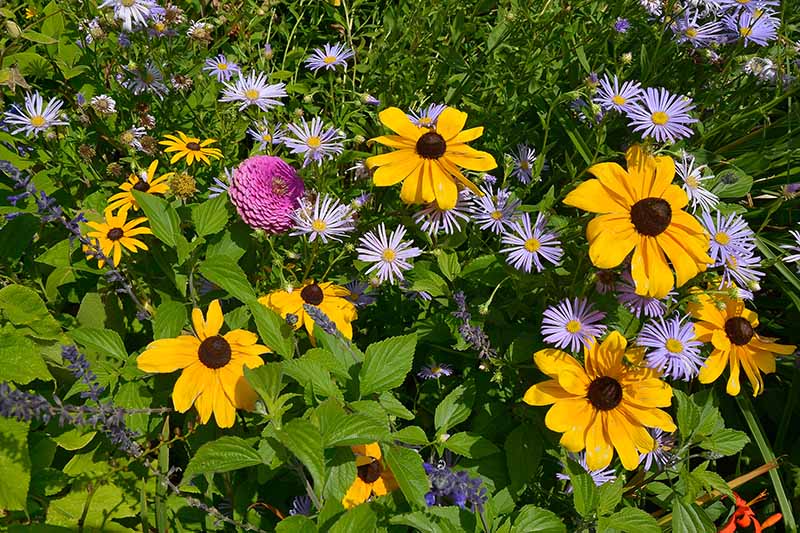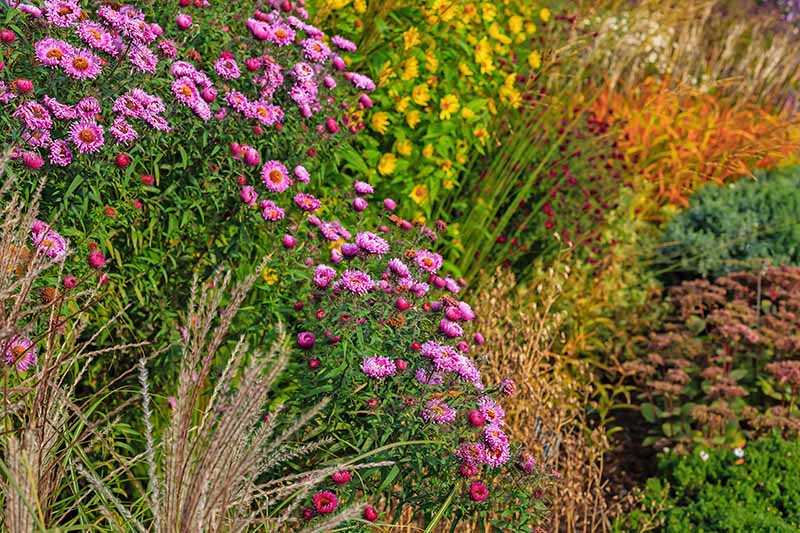Aster Companion Plants That Will Make Your Fall Garden Pop
Asters are a popular choice for fall gardens, and for good reason. They come in a wide range of colors, from white and pink to purple and blue, and they bloom for weeks on end. But asters can look even better when they're planted with companion plants. The right companions can add height, texture, and interest to your fall garden, and they can also help to attract pollinators.
Here are a few of the best companion plants for asters:
- Black-eyed Susans. These cheerful yellow flowers bloom at the same time as asters, and they make a great contrast in color. Black-eyed Susans are also relatively low-maintenance, so they're a good choice for busy gardeners.

- Coneflowers. Coneflowers are another popular fall flower, and they come in a variety of colors, including purple, pink, and yellow. They're also tall and stately, so they can help to anchor your fall garden.

- Goldenrods. Goldenrods are a classic fall flower, and they add a touch of sunshine to any garden. They're also relatively easy to care for, and they can tolerate a variety of soil conditions.

- Yarrow. Yarrow is a low-growing perennial with bright flowers that bloom in late summer and early fall. It's a good choice for filling in the spaces between taller plants, and it can also help to attract butterflies and other pollinators.

- Ornamental grasses. Ornamental grasses add height and texture to any garden, and they're especially beautiful in the fall when their leaves turn golden or red. Some popular ornamental grasses for fall gardens include fountain grass, bluestem, and maidenhair grass.

- Sunflowers. Sunflowers are a fun and cheerful addition to any garden, and they can add a touch of whimsy to your fall display. They're also tall and stately, so they can help to anchor your garden.

- Zinnia. Zinnias are a colorful and easy-to-grow annual that blooms in late summer and early fall. They come in a wide range of colors, so you can find the perfect ones to complement your asters.

When choosing companion plants for asters, it's important to consider the plant's height, bloom time, and sun requirements. You'll also want to make sure that the plants you choose will complement each other in terms of color and texture.
With a little planning, you can create a fall garden that's both beautiful and inviting. By planting asters with the right companion plants, you can extend the color and interest in your garden for weeks on end.
Asters are beautiful flowers that add a touch of fall color to any garden. But did you know that they can also attract beneficial insects and pollinators? The right companion plants can help to improve the health and productivity of your asters, and they can also add visual interest to your garden.
Some of the best companion plants for asters include:
- Yarrow: This hardy perennial blooms from late summer to fall, and it attracts butterflies and other beneficial insects.
- Black-eyed Susans: These cheerful flowers bloom from late summer to fall, and they come in a variety of colors.
- Coneflowers: These spiky flowers bloom from late summer to fall, and they attract butterflies and other pollinators.
- Goldenrod: This tall, graceful flower blooms from late summer to fall, and it adds a touch of yellow to your garden.
- Hydrangeas: These showy flowers bloom from late spring to early fall, and they come in a variety of colors.
For more information about aster companion plants, please visit Gardenia Inspiration. This website has a wealth of information on asters and other garden plants, and it's a great resource for gardeners of all levels of experience.
FAQ of aster companion plants
- What are some good companion plants for asters?
Asters are relatively easy-going plants and can be paired with a variety of other plants. Some good companion plants for asters include:
* Chrysanthemums: These two plants are in the same family and have similar growing requirements. They can be planted together to create a continuous display of blooms from late summer to fall.
* Cosmos: Cosmos are another type of daisy-like flower that blooms in the summer and fall. They are tall and airy, so they can help to add some height and structure to an aster planting.
* Echinacea: Echinacea is a native North American plant that is known for its medicinal properties. It is also a beautiful addition to any garden, with its bright purple flowers.
* Goldenrod: Goldenrod is a tall, yellow-flowered plant that blooms in late summer and fall. It is a good choice for attracting pollinators to the garden.
* Shasta daisy: Shasta daisies are another type of daisy-like flower that blooms in the summer and fall. They are white and daisy-like, so they can help to add some contrast to an aster planting.
- What are some benefits of planting companion plants with asters?
There are several benefits to planting companion plants with asters. Some of these benefits include:
* Attracting pollinators: Asters and their companion plants can attract a variety of pollinators, such as butterflies, bees, and hummingbirds. These pollinators are important for pollinating flowers and crops, which helps to ensure a healthy ecosystem.
* Disease and pest control: Some companion plants can help to deter pests and diseases from aster plants. For example, marigolds are known to repel nematodes, which can be a problem for aster plants.
* Improved soil quality: Some companion plants can help to improve the soil quality around aster plants. For example, legumes fix nitrogen in the soil, which can provide aster plants with a valuable nutrient.
* Enhanced appearance: Companion plants can help to enhance the appearance of an aster planting. For example, tall plants can help to add height and structure, while shorter plants can help to fill in the gaps.
- What are some common problems that asters can face?
Asters are relatively hardy plants, but they can be susceptible to a few common problems. Some of these problems include:
* Aster wilt: Aster wilt is a fungal disease that can cause aster plants to wilt and die. This disease is most common in wet, humid conditions.
* Aster leaf spot: Aster leaf spot is a fungal disease that can cause spots to appear on aster leaves. This disease is most common in warm, humid conditions.
* Aster rust: Aster rust is a fungal disease that can cause rust-colored spots to appear on aster leaves. This disease is most common in cool, wet conditions.
* Aphids: Aphids are small, sap-sucking insects that can damage aster plants. They can cause leaves to wilt and curl, and they can also spread diseases.
* Spider mites: Spider mites are tiny, spider-like insects that can damage aster plants. They can cause leaves to yellow and wilt, and they can also spread diseases.
- How can I prevent problems with asters?
There are a few things you can do to help prevent problems with asters. Some of these things include:
* Plant aster varieties that are resistant to common diseases.
* Water asters deeply and regularly, but avoid overwatering.
* Fertilize asters with a balanced fertilizer in the spring and fall.
* Inspect aster plants regularly for signs of pests and diseases.
* Treat any pests or diseases that you find promptly.
- How can I care for aster plants?
Asters are relatively easy to care for. Here are some basic care tips:
* Plant asters in full sun to partial shade.
* Water asters deeply and regularly, but avoid overwatering.
* Fertilize asters with a balanced fertilizer in the spring and fall.
* Deadhead spent flowers to encourage more blooms.
* Protect aster plants from frost in colder climates.
Image of aster companion plants
- Aster and coneflower: These two plants have similar flower shapes and colors, so they look great planted together. They also have similar growing requirements, so they are easy to care for.

- Aster and black-eyed Susan: These two plants bloom at different times of the year, so they can provide color in your garden all season long. Black-eyed Susans are also deer-resistant, so they are a good choice if you have a problem with deer in your yard.

- Aster and grasses: Grasses add height and texture to a garden, and they can help to anchor asters that tend to flop over. Some good choices for companion grasses include big bluestem, switchgrass, and feather reed grass.

- Aster and sedges: Sedges are another good choice for companion plants for asters. They come in a variety of colors and textures, so you can find some that will complement the colors of your asters.

- Aster and wildflowers: Wildflowers are a great way to add a touch of natural beauty to your garden. They also attract pollinators, which is beneficial for the environment. Some good choices for wildflowers to plant with asters include goldenrod, yarrow, and coneflower.

Post a Comment for " Aster Companion Plants That Will Make Your Fall Garden Pop"